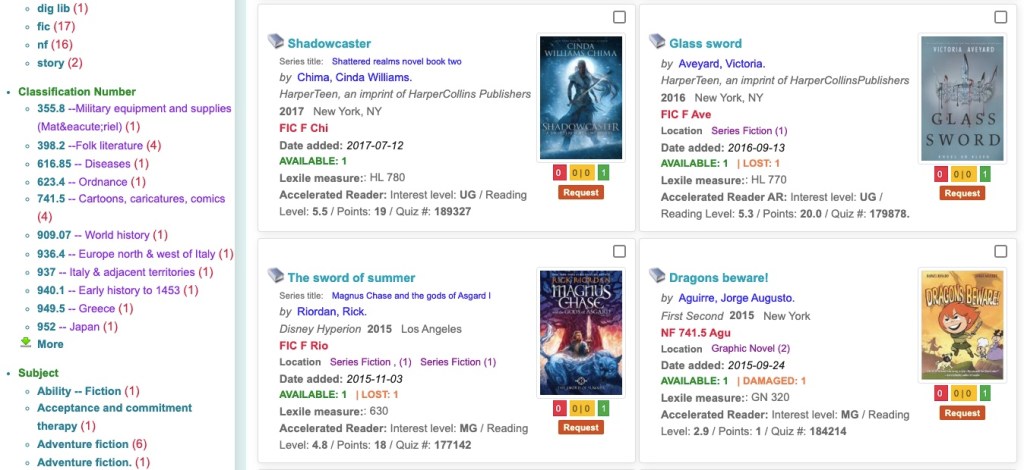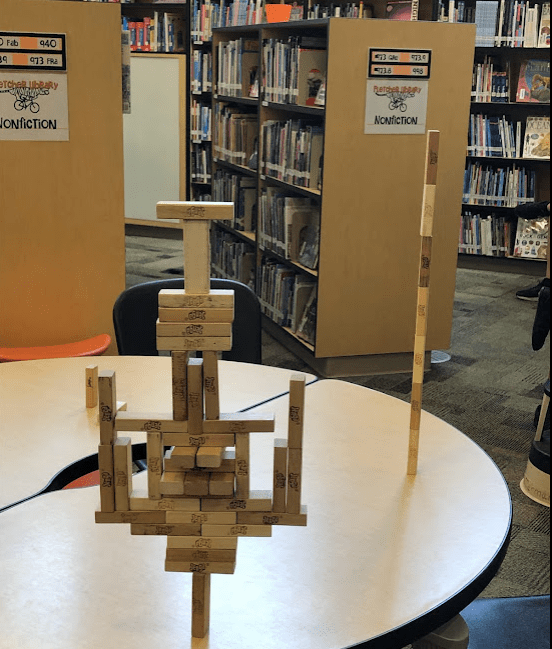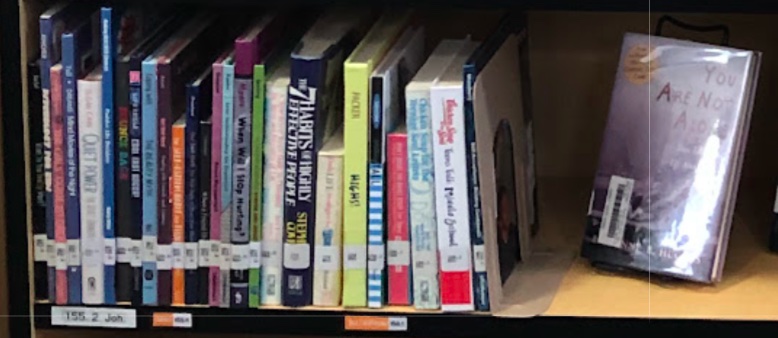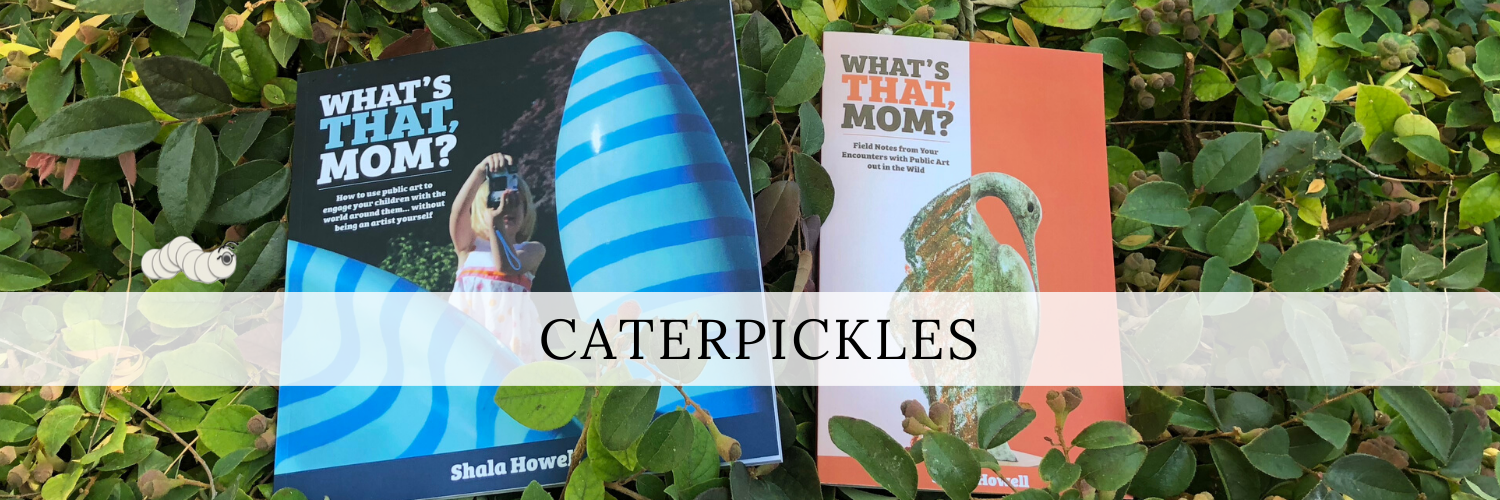Making our nonfiction section more browse-able

A stack of books from our nonfiction section that our students found & read because we put them on display somewhere else. (Photo: Shala Howell)
I spent much of my first year as a library worker observing how middle school students use a library. Having the luxury of running the circulation desk and the Hold Shelf, it was easy for me to see which books were being checked out and which weren’t. It didn’t take long for me to pick up on the fact that at the beginning of the year, most of the nonfiction books that students checked out for themselves were being reserved online and funneled through the Hold Shelf.
I began to wonder if this was because nonfiction feels inscrutable to the average library user. Sure, nonfiction books are technically sorted according to numbers assigned to their primary topic. But while the Dewey Decimal System seems like it ought to be a perfectly orderly way to organize and care for an extensive nonfiction collection, in actual fact cataloguing books seems to be more of an art than a science. Books are assigned a Dewey Decimal Number based on a human’s assessment of their primary topic. But books are messy and authors frequently talk about more than just one thing in them. Which is where the inscrutability comes in.
The inscrutability problem
A student wandered into our library one day last fall looking for a book about swords, so that he could make a prop for a play he was going to be in later that semester. He did a catalog search, but was unable to determine which book he needed from it. So he asked me for help.
When I tried a keyword search for “sword,” the library catalog returned two pages of results, including nonfiction books scattered in almost a dozen different places. No wonder he couldn’t find what he wanted on his own.

I turned the computer so that he could see my results and began asking him questions.
- Do you want a real sword or an artistic model of one? He wanted a historically accurate sword to work from, so we ruled out all the fiction, graphic novels (741.5), and fairy tales (398.2).
- Do you have a time period in mind? He was ok with Ancient Rome (936.4 and 937), but really wanted a sword based on the Middle Ages (909.7 and 940.1).
I wrote down the Dewey Decimal numbers for the books about swords in the Middle Ages and we set off for the nonfiction stacks.
Along the way I asked him if he knew how the nonfiction section was organized.
When he said, yes, but it had been a long time, I gave him a version of what became my standard spiel: Books in nonfiction are organized first by number and then by author’s last name. In our library you will find 000-500 in the stacks along the wall and 600-900 in these freestanding stacks in the middle. Each stack is labeled to tell you the numbers assigned to the books inside it. And so on.
I didn’t expect him to remember it.
But apparently he did, because the next week he came in to check out a book on Vikings. Which he’d found in the stacks without my help. In fact, throughout the year, he routinely came back to check out nonfiction books on various completely unrelated topics–advertising, finance, architecture–without asking for my help first.
Greatly encouraged by this, I began giving that same spiel to every student who asked for my help finding a nonfiction book.
It worked with some of them, not so much with others. But by the end of the year I noticed many more students using the nonfiction section routinely on their one. A few, like my first student, felt comfortable enough to find a wide variety of books on their own. Others had me help them find where the topic they were interested in primarily lived, and then returned on their own to that spot in the following weeks to check out one book after another.
Apparently, it is possible to teach someone how to use a nonfiction section without making a big deal out of it. Interesting.
Still, no one, not even my dedicated nonfiction readers who returned week after week for a new nonfiction book, actually browsed the nonfiction section.
They either determined where to find what they wanted through the catalog before venturing into the stacks or memorized the general spot they were interested in and went straight there. There was no deviation from this behavior, no wandering up and down the stacks, like my readers did in the fiction and graphic novel sections. Or like I do while wandering through the nonfiction section of my favorite bookstore.
These students were never going to find any of the hidden gems that I knew were in the nonfiction stacks.
Watching this over time I got to wondering…
What if I could make nonfiction more browse-able?
There are many problems with the Dewey Decimal System. It is chock full of racism, for one thing (CW: language), but I am a mere Library Assistant in a district that uses the Dewey Decimal System. Ditching Dewey is simply not a thing I’m empowered to do. But I do like the idea of making our nonfiction section feel more like the nonfiction section in a bookstore, instead of a wall of books organized by arcane numerical wizardry.
So I began to do some experimenting.

What would happen if I labeled the nonfiction shelves to call out important topics about teenage life?
My first attempts dealt with reworking the signage in the nonfiction section to highlight the sorts of topics that if I were a middle schooler I would want to read about but not ask an adult for help finding: mental illness, drug use, LGBTQ+ issues, puberty, divorce, grief, that sort of thing.
I wish I could claim to have come up with this idea all on my own, but the truth is, I got the idea from one of the librarians I follow on Twitter who posted a photo of her library’s Tough Topics list. It’s a sign that hangs in several places in their nonfiction section that tells patrons the Dewey Decimal numbers for topics they may be interested in, but are too embarrassed or simply reluctant to ask about.
I made one of these signs for us (relabeling it “Life Topics” on the advice of my Teacher Librarian) and placed a copy of it on the walls in Nonfiction and on my Book Recommendations Wall. I also made little orange shelf labels for each topic, which I stationed on the shelves themselves to highlight where the books for those topics lived.

Did I see a boost in nonfiction circulation from all of this?
Not really. But I did start seeing additional chaos in those portions of the shelves, which told me students were pulling the books, flipping through them, and placing them back in their-best-guess-for-the-right-spot.
Was that good enough for me to keep experimenting? You betcha.
But this post is already pretty long, so I’ll save the rest for next time.
Related Links:
- An end of the year library report and why it matters (Caterpickles)
- Racism in the Dewey Decimal System (Bookriot, Content Warning: Language)


8 Responses to “Making our nonfiction section more browse-able”
Great post with some really helpful ideas. Looking forward to reading your next post about this.
LikeLiked by 1 person
Thank you! I have two more coming in this series. If you have any thoughts on things I can try, I would love to hear them.
Thanks for stopping by Caterpickles!
LikeLiked by 1 person
[…] Making our nonfiction section more browse-able (Caterpickles) […]
LikeLike
[…] In Part 1, I discussed the nonfiction inscrutability problem and some of my early attempts to decode…: assisting them with search queries, teaching them how to use nonfiction one-on-one, and adding signage to highlight topics that are often important to teenagers, but that they don’t always want to ask adults for help finding books about. […]
LikeLike
[…] Making our nonfiction section more browse-able (Caterpickles) […]
LikeLike
[…] Making our nonfiction section more browse-able: Part 1 (Caterpickles) […]
LikeLike
[…] Making our nonfiction section more browse-able (Caterpickles) […]
LikeLike
[…] Making our nonfiction section more browse-able (Caterpickles) […]
LikeLike